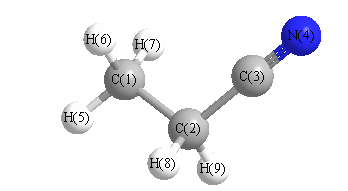Vibrational Frequencies calculated at CCSD/TZVP
| Mode Number |
Symmetry |
Frequency
(cm-1) |
Scaled Frequency
(cm-1) |
IR Intensities
(km mol-1) |
Raman Act
(Å4/u) |
Dep P |
Dep U |
|---|
| 1 |
A' |
3163 |
3018 |
22.25 |
|
|
|
| 2 |
A' |
3099 |
2958 |
8.07 |
|
|
|
| 3 |
A' |
3081 |
2941 |
17.68 |
|
|
|
| 4 |
A' |
2362 |
2254 |
1.08 |
|
|
|
| 5 |
A' |
1529 |
1460 |
4.77 |
|
|
|
| 6 |
A' |
1507 |
1438 |
4.07 |
|
|
|
| 7 |
A' |
1455 |
1389 |
0.93 |
|
|
|
| 8 |
A' |
1389 |
1326 |
3.50 |
|
|
|
| 9 |
A' |
1118 |
1067 |
2.98 |
|
|
|
| 10 |
A' |
1037 |
990 |
0.77 |
|
|
|
| 11 |
A' |
850 |
811 |
0.82 |
|
|
|
| 12 |
A' |
542 |
517 |
0.56 |
|
|
|
| 13 |
A' |
209 |
200 |
4.03 |
|
|
|
| 14 |
A" |
3168 |
3023 |
22.80 |
|
|
|
| 15 |
A" |
3139 |
2996 |
0.32 |
|
|
|
| 16 |
A" |
1524 |
1455 |
6.27 |
|
|
|
| 17 |
A" |
1310 |
1250 |
0.14 |
|
|
|
| 18 |
A" |
1140 |
1088 |
0.56 |
|
|
|
| 19 |
A" |
805 |
768 |
1.29 |
|
|
|
| 20 |
A" |
381 |
364 |
0.27 |
|
|
|
| 21 |
A" |
227 |
217 |
0.97 |
|
|
|
Unscaled Zero Point Vibrational Energy (zpe) 16516.9 cm
-1
Scaled (by 0.9544) Zero Point Vibrational Energy (zpe) 15763.7 cm
-1
See section
III.C.1 List or set vibrational scaling factors
to change the scale factors used here.
See section
III.C.2
Calculate a vibrational scaling factor for a given set of molecules
to determine the least squares best scaling factor.
